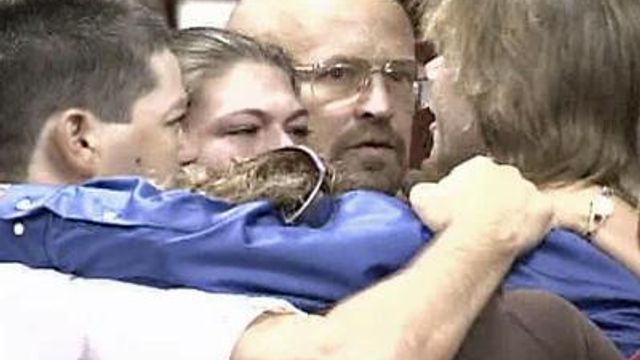Lawyer: Exonerated Man One of Many Wrongly Imprisoned
The release of a Wayne County man wrongly convicted of child rape was the first secured by the North Carolina Center for Actual Innocence. The nonprofit is asked to investigate around 1,000 claims of innocence by state inmates each year.
Posted — Updated
Dail threw back his head and hugged his attorney when Superior Court Judge Jack Hooks Jr. said he was a free man.
Asked by reporters if he thought his conviction would ever be set aside, an animated and excited Dail shook his head. "No, I did not," he said, hugging his mother, Rosa Dail, as other crying family members stood nearby. "I'm a blessed man."
Dail said the feeling of "great justice" overwhelmed him as he walked out of the courthouse, accompanied by his mother and the media.
"Y'all had me so distracted I didn't even realize I was out in the sun!" Dail told the crowd that surrounded him. "No shackles, no handcuffs, no chains!"
DNA testing on recently rediscovered evidence excluded Dail as the man who entered a Goldsboro home through a window and raped a 12-year-old girl on Sept. 4, 1987. The N.C. Center on Actual Innocence helped push to find that DNA evidence after beginning to investigate Dail's case in 2001.
Dail is one of around 200 wrongly-imprisoned inmates across the nation to be exonerated by the work of nonprofit agencies, such as the Center. In North Carolina, the Center is asked to investigate around 1,000 claims of innocence by state inmates each year, the Center’s executive director, Christine Mumma, said.
“It’s all about getting to the truth,” Mumma said.
Despite his claims of innocence, a jury sentenced Dail to two life sentences, plus 18 years, in 1989 for first-degree rape, as well as other charges stemming from the same incident. At his trial, the victim identified Dail as her attacker, and hair found at the scene was found to be microscopically consistent with his.
Despite the best efforts of police and witnesses, testimony and evidence can often prove to be inaccurate, helping move juries to wrongful convictions, Mumma said.
"Unfortunately, we get a lot of cases where there is not anything we can do, where there is not any DNA evidence, where it's one person's word against another, and the jury has heard all the facts," she said.
Dail never admitted guilt and continued to proclaim his innocence from prison.
"This should never have happened. This was not an accidental case," he said on Tuesday.
Successfully exonerating wrongly convicted inmates is an uphill battle, said Mumma, who also acted as Dail's lawyer. Much of the Center’s footwork to prove Dail’s release was done by students at the state’s top law schools.
“You write down all the humans that come into contact with each case, and there is a lot of potential for human error, unintentional, unavoidable human error,” she said.
"But in the cases where we can do something, that's where we need to put our efforts," she added.
The evidence from Dail’s case was originally believed to have been destroyed after a period of time, which is standard protocol. When a police officer originally involved in the case retired, however, authorities found a piece of the girl's nightgown in an evidence bag in his desk drawer.
Authorities turned over the evidence to the State Bureau of Investigation and on Monday, learned that DNA on the victim's nightgown matched a different person.
Less than 24 hours after the DNA results were known, Wayne County District Attorney Branny Vickory asked Hooks to release Dail, saying he was an innocent man.
"He, indeed, has been in prison unjustly, incorrectly for the last 18 years," Vickory said Tuesday. He asked the judge to dismiss the original charges with prejudice, meaning Dail cannot be retried on the charges.
Hooks said the new evidence proved "overwhelmingly that the wrong person went to prison." Vickory added that since Dail did not commit the rape, he could not have been involved in the crime, which was committed by one attacker.
As the Center celebrates the first release to result from its work, Dail’s exoneration underscores the need for the Center's work, Mumma said.
“I keep a list of 12 cases with me all the time, that are cases where I, 100 percent, believe in their innocence,” she said. “And we are trying to do something about them. Dwayne Dail was one of them.”
Mumma said she plans to ask the governor to grant a seek a full pardon to Dail and plans also to seek financial compensation. Dail could receive $20,000 for each year of wrongful imprisonment.
Investigators have reopened the 1987 rape case. Vickory asked Hooks to keep the evidence sealed while investigators search for a suspect. Mumma predicted that a DNA match to a suspect will be made soon.
Dail said he plans to take some time and go to the beach with his family. He also wants to visit the grave site of his brother, who died while he was in prison, and connect with his 18-year-old son, who was born after he entered prison.
“Today is the first day of the rest of my life, and I’m absolutely going to make the most of it,” Dail said.
• Credits
Copyright 2024 by Capitol Broadcasting Company. All rights reserved. This material may not be published, broadcast, rewritten or redistributed.






